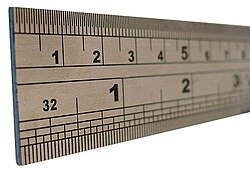Unit of length
A unit of length is a way of measuring length or distance.
Common units of length in the International System of Units (SI) are:
- metre and units that are developed from it, such as "centimetre" or "kilometre"
But there are a lot of units that do not fit in the SI-System:
- fermi (fm) (= 1 femtometre in SI units)
- angstrom (Å) (= 100 picometres in SI units)
- micron (= 1 micrometre in SI units)
- Norwegian/Swedish mil (= 10,000 metres)
Common Imperial units and U.S. customary units of length include:
- inch (25.4 mm)
- mil (one thousandth of an inch, one thou)
- foot (0.3048 m, 12 inches)
- yard (0.9144 m)
- (terrestrial) mile (1609.344 m)
In addition, the following are used by mariners:
- fathom (for depth) (1.8288 m)
- nautical mile (1852 m)
Surveyors in the United States continue to use:
Horse racing keeps alive:
- furlong (~201 m)
Astronomical measure uses:
- astronomical unit (AU) (~149 gigametres)
- light year (ly) (~9.46 petametres)
- parsec (pc) (~30.8 petametres), including kiloparsec (kpc) and megaparsec (Mpc)
Physics also uses:
Old units of distance are:
- cana
- cubit
- league
- li (China)
- pace (the "double pace" of about 5 feet used in Ancient Rome)
- verst (Russia)
In everyday conversation, and in informal literature, it is common to see lengths measured in units of objects of which everyone knows the approximate width. Common examples are:
- Football field (generally around 110 metres, depending on the country)
- Widths of a human hair (around 80 micrometres)

